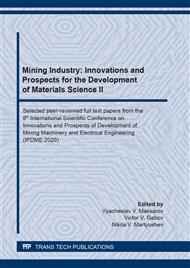p.159
p.168
p.174
p.181
p.194
p.203
p.212
p.218
p.224
Concentration Dependence of the Surface Tension of Three and Four-Component Systems with Peculiarities in the Surface Tension Isotherms of Lateral Binary Melts
Abstract:
The experimental study results of the melts concentration dependence of the surface tension of the four-component indium-tin-lead-bismuth system and its constituent binary systems of indium-tin, indium-lead, indium-bismuth, tin-lead, tin-bismuth, lead-bismuth are presented in the paper. It is shown that the concentration dependence of the melts surface tension of the In-Sn-Pb-Bi four-component system can be predicted from the data on ST (surface tension) values of lateral binary systems. Features in the ST isotherms in the form of a minimum are observed only in the indium-tin lateral system from all lateral binaries. A distinctive feature of the detected minimum is that the minimum depth slightly exceeds the experimental error. Therefore, in addition to the fact that the area of average compositions was studied more thoroughly, we carried out the surface tension measurements by two independent methods. The experimental data obtained by both methods coincide within the experimental error and indicate the extremum availability on ST isotherms. Thus, ST experimental studies by two independent methods confirmed the presence of a flat minimum on ST isotherms of the indium-tin binary system increasing the reliability of the obtained data. The obtained outcomes and their comparison with experimental data have shown that the considered models for predicting surface properties based on data due to similar properties of lateral binary systems adequately reflect the experimental dependences. However, the prediction model based on Kohler's method of excess values describes the experimental curves more accurately.
Info:
Periodical:
Pages:
194-202
Citation:
Online since:
February 2021
Authors:
Price:
Сopyright:
© 2021 Trans Tech Publications Ltd. All Rights Reserved
Share:
Citation:


